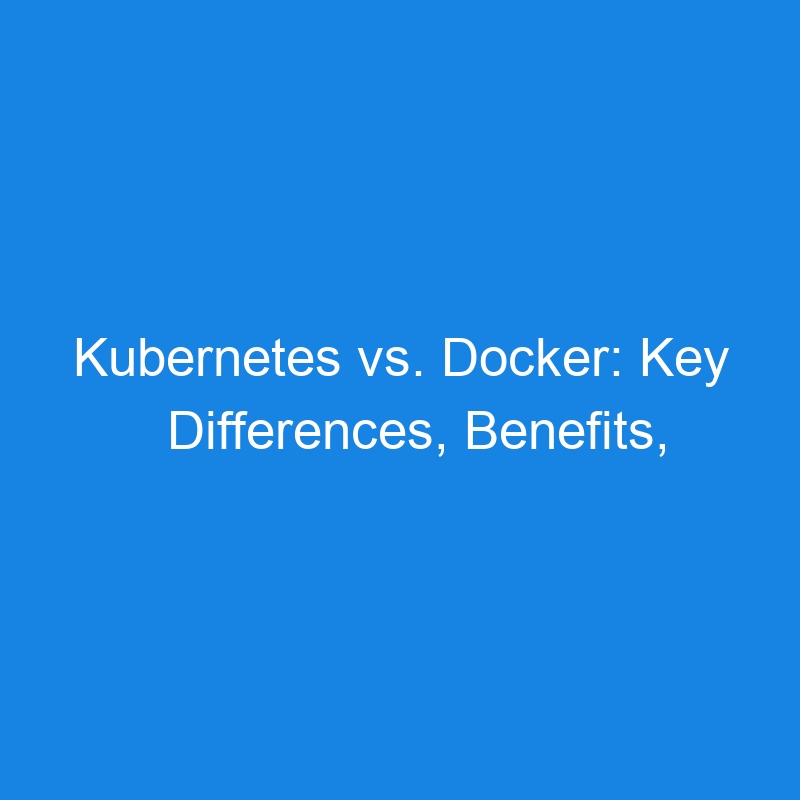Kubernetes vs. Docker: Key Differences and Benefits
Kubernetes and Docker are both essential technologies for containerized application deployment and management, but they serve different purposes and work in conjunction with each other. While Docker is focused on creating and running containers, Kubernetes orchestrates and manages these containers at scale. In this article, we’ll explore the key differences between Kubernetes and Docker, along with their respective benefits.
What is Docker?
Docker is a platform and toolset that allows developers to create, deploy, and manage containers. Containers are lightweight, portable, and ensure consistency across environments, from development to production.
Key Features of Docker:
- Containerization: Docker allows applications and their dependencies to be packaged into containers that can run anywhere, regardless of the underlying environment.
- Docker Engine: The core component that runs and manages containers.
- Docker Hub: A cloud-based registry for sharing container images.
- Docker Compose: A tool for defining and running multi-container Docker applications.
Benefits of Docker:
- Portability: Containers can run on any platform that supports Docker, ensuring that your application behaves the same way in any environment.
- Efficiency: Docker containers are lightweight, requiring fewer resources compared to virtual machines (VMs).
- Isolation: Docker provides strong isolation between containers, which helps in avoiding conflicts between dependencies.
- Simplified Development: Docker simplifies the process of developing, testing, and deploying applications by ensuring consistency across environments.
What is Kubernetes?
Kubernetes (K8s) is an open-source container orchestration platform for automating the deployment, scaling, and management of containerized applications. While Docker focuses on the containerization of individual applications, Kubernetes handles the management of those containers, especially at scale.
Key Features of Kubernetes:
- Pod-based Architecture: Kubernetes organizes containers into “pods,” which are groups of containers that share the same network and storage resources.
- Service Discovery and Load Balancing: Kubernetes can expose applications to the internet and balance the load across containers.
- Auto-scaling: Kubernetes can scale applications automatically based on load or resource usage.
- Self-healing: Kubernetes ensures that the desired state of the application is maintained by restarting failed containers and replacing nodes if necessary.
- Declarative Configuration: Kubernetes uses YAML or JSON files to define desired configurations, allowing for repeatable deployments.
Benefits of Kubernetes:
- Scalability: Kubernetes can handle the deployment and management of large numbers of containers across clusters of machines.
- High Availability: Kubernetes ensures that applications remain available and reliable through features like pod replication and automated failover.
- Auto-scaling: Kubernetes dynamically adjusts the number of running instances based on traffic or resource usage, optimizing costs and performance.
- Environment Consistency: Kubernetes abstracts away the underlying infrastructure, allowing teams to define and manage environments consistently.
- Rolling Updates and Rollbacks: Kubernetes allows you to deploy new versions of applications with minimal downtime and easily rollback to previous versions if needed.
Key Differences Between Kubernetes and Docker
| Feature | Docker | Kubernetes |
|---|---|---|
| Purpose | Containerization | Container orchestration and management |
| Scope | Manages individual containers | Manages clusters of containers |
| Deployment | Primarily handles single-container apps | Manages multi-container, multi-node apps |
| Scaling | Docker doesn’t handle scaling by itself | Kubernetes can automatically scale apps |
| State Management | Not designed for managing app states | Ensures the desired state of apps is maintained (self-healing) |
| Networking | Basic networking (via Docker networks) | Advanced networking, including service discovery and load balancing |
| Complexity | Simpler, focused on container creation and running | More complex, designed for large-scale container orchestration |
| Dependency Management | Manages dependencies within a container | Manages dependencies across containers and nodes in a cluster |
| Storage Management | Requires Docker Volumes for persistent storage | Handles persistent storage across nodes with StatefulSets and persistent volumes |
| Use Case | Ideal for developing and running individual containers | Ideal for managing large-scale, distributed applications |
When to Use Docker vs. Kubernetes?
Use Docker if:
- You are working with single-container applications or small-scale applications.
- You need a lightweight solution for containerization and don’t require advanced orchestration.
- You are looking for local development and testing environments for containers.
- You are looking to package and distribute applications across various environments (e.g., development, staging, production).
Use Kubernetes if:
- You are running large-scale applications with multiple containers that need to be orchestrated and managed across multiple nodes.
- You need high availability and auto-scaling for your applications.
- You require self-healing for your applications and need to automatically handle failures.
- You want to manage deployments, updates, and rollbacks seamlessly in production environments.
- You need to run your containers on a cluster of machines and manage the overall container lifecycle across these machines.
How Do Kubernetes and Docker Work Together?
While Docker and Kubernetes serve different roles, they are often used together in the containerized application lifecycle:
- Docker is used to build, package, and run individual containers.
- Kubernetes is used to manage these containers at scale, across multiple nodes, and provide features like auto-scaling, self-healing, and load balancing.
In essence, Docker runs the containers, and Kubernetes orchestrates and manages these containers across clusters of machines.
Conclusion
- Docker is an essential tool for developers who want to containerize applications and ensure consistent environments, while Kubernetes is a powerful tool for managing, scaling, and orchestrating those containerized applications in production.
- Docker is best suited for container creation and small-scale applications, while Kubernetes is designed for automating the management of containerized applications at scale.
- Together, Docker and Kubernetes form a robust ecosystem that powers modern cloud-native applications and microservices architectures.
By understanding the roles and benefits of both technologies, you can make informed decisions about when and how to use them effectively in your infrastructure.
